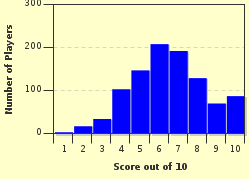Quiz Answer Key and Fun Facts
1. What is a subatomic particle?
2. For every particle of matter there is a corresponding particle with identical mass and spin but opposite charge. What are these corresponding particles called?
3. Everything must be weighed, even subatomic particles. What standard term is used for expressing the mass of protons, neutrons and electrons?
4. Back in the 1940's, before scientists had the instruments to discover the subatomic particles we know today, theoretical physicists George Gamow and Ralph Alpher invented a term for the original substance--the substance that existed right after the Big Bang. What is this term which is derived from the Greek word for "matter?"
5. To gain some perspective on the relative sizes of subatomic particles, if an atom was the size of a baseball field, what could represent the nucleus?
6. The great physicist Max Planck hypothesized that some types of energy could not take on any value. The value must be a multiple of a very small quantity. What is that quantity called?
7. Which of the following is NOT an actual quantum scale?
8. What is the name of the theory that states that all forces stem from one force that existed long ago?
9. Boson particles have superpartners called fermions that differ by half a unit of spin. The boson particles are gluons, photons, W bosons and Z bosons. The photon's superpartner is called photino and the gluon's superpartner is called gluino. What is the W boson's superpartner called?
10. Baryon degenerate matter is matter in which all the quantum energy states has been occupied. As an example, when a star collapses into itself it is called a neutron star and is composed of baryon degenerate matter. In a neutron star, electrons, which normally orbit the nucleus, are flopped into the nucleus where they merge with protons. What do they become after they merge (remember, electrons have a negative charge, protons have a positive charge)?
Source: Author
deputygary
This quiz was reviewed by FunTrivia editor
crisw before going online.
Any errors found in FunTrivia content are routinely corrected through our feedback system.

